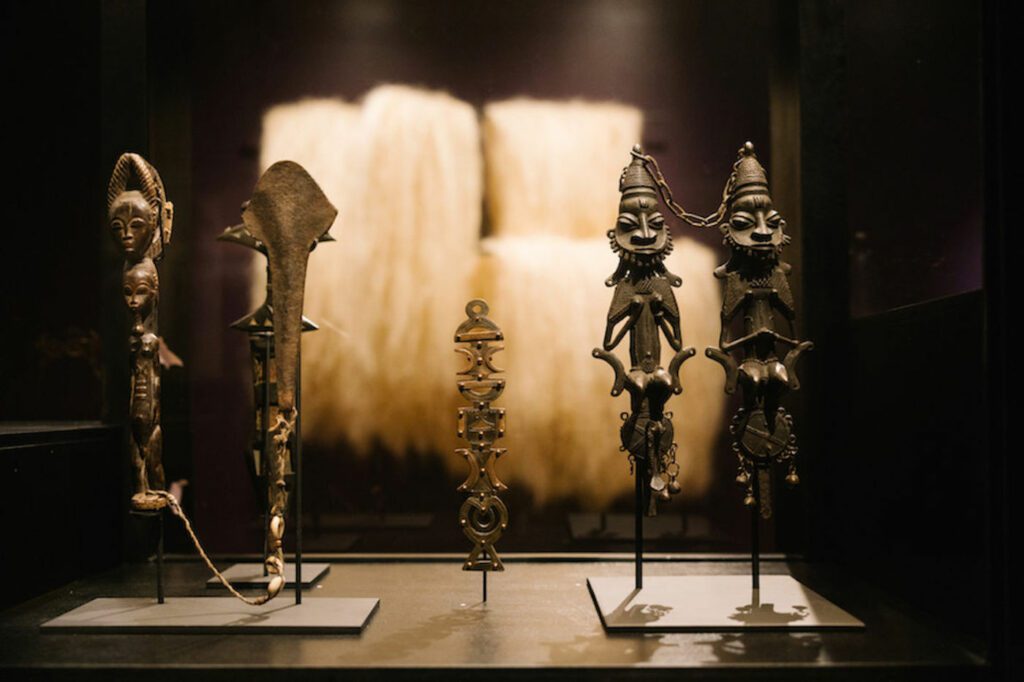Bard Graduate Center, New York, United States
29 Sep 2023 - 31 Dec 2023

Exhibition view of SIGHTLINES on Peace, Power & Prestige at the Bard Graduate Center Gallery. Photo by Da Ping Luo.
SIGHTLINES on peace, power, and prestige: metal arts in africa builds a conversation between historic and contemporary works from Africa and the african diaspora to deconstruct how we make meaning around african material culture in a post-colonial world. The exhibition includes historic african objects and works by living artists: Radcliffe Bailey, Sharif Bey, Sammy Baloji, Lubaina Himid, Bronwyn Katz, Kapwani Kiwanga, Abigail Lucien, Tsedaye Makonnen, Otobong Nkanga, Julia Phillips, Zohra Opoku, Nari Ward, and Amanda Williams.
This fall Bard Graduate Center will present SIGHTLINES on Peace, Power, and Prestige: Metal Arts in Africa, bringing together African metal arts dating predominantly from the 19th and early 20th centuries with contemporary works by artists from Africa and the African diaspora to catalyze a shift in the interpretation and understanding of African art and material culture. Through its design and curation, SIGHTLINES challenges long-held conventions of keeping African historic and contemporary works separate and siloed, and instead puts them in relationship with each other by creating literal and metaphorical sightlines.
The exhibit features large-scale sculptures, photography, weavings, metal work, and multi-media installations by contemporary makers Radcliffe Bailey, Sharif Bey, Lubaina Himid, Bronwyn Katz, Kapwani Kiwanga, Abigail Lucien, Tsedaye Makonnen, Otobong Nkanga, Julia Phillips, Zohra Opoku, Nari Ward, and Amanda Williams, as well as the US premiere of photographer Sammy Baloji’s documentary film Of the Moon and Velvet, about metal extraction in the Democratic Republic of Congo. The more than 140 historic works on view include staffs and figures from the Mande smiths of Mali; regalia of the Edo chiefs of Nigeria; sacred objects of the Tusian, Gan, and Lobi peoples of Burkina Faso; ceremonial swords, gold weights, and personal adornment of the Akan people of Ghana; currencies, ceremonial staffs, and weaponry from Congo, as well as a broad range of other extraordinary works in metal.
The exhibition installation, designed by architecture firm AD–WO, provokes conversations between the past and present with a layout that maps sightlines between the historic and contemporary objects, and between makers, users, and viewers. Eschewing traditional display conventions, a series of long walls unites the galleries on each floor. The historic metal works are mounted by theme on platforms of varying height within the walls, which facilitate unexpected associations to form among objects from vastly different cultures, geographies, and time periods. The contemporary works will be installed outside of the walls, enabling visitors to view them both in individually and through the transparent plexiglass of the long walls, creating constantly shifting associations with the historic objects as one moves through the galleries. The work of AD–WO, founded by Emanuel Admassu and Jen Wood, was exhibited in Reconstructions: Architecture and Blackness in America at the Museum of Modern Art (MoMA) in 2021 and will be featured at the Venice Biennale Architettura 2023. The firm’s practice is committed to design that reimagines the sociopolitical dynamics of space and its contexts.
“With this exhibition we want to destabilize accepted ways of seeing and thinking about these objects, and reveal how they tell continuous, interrupted, and interlacing stories of the issues, ideas, and experiences that communities from Africa and the African Diaspora have lived and are grappling with today,” said Drew Thompson, associate professor at Bard Graduate Center and curator of SIGHTLINES on Peace, Power, and Prestige: Metal Arts in Africa. “The role AD–WO and the living artists play in this exploration is essential to drawing out the nuanced, rich history around these objects and the ways in which they continue to influence and impact our contemporary understanding of identity and the world at large today. We also want to engage with the discussion surrounding reparation and restitution of African art objects, which is not restricted to the current moment but was foundational to the making and use of metal objects on the continent and in the Diaspora across centuries and geographies.”